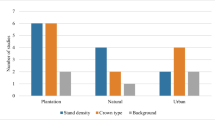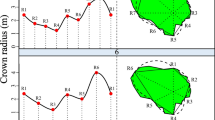Abstract
This study investigated which predictor variables with respect to crown properties, derived from small-footprint airborne light detection and ranging (LiDAR) data, together with LiDAR-derived tree height, could be useful in regression models to predict individual stem volumes. Comparisons were also made of the sum of predicted stem volumes for LiDAR-detected trees using the best regression model with field-measured total stem volumes for all trees within stands. The study area was a 48-year-old sugi (Cryptomeria japonica D. Don) plantation in mountainous forest. The topographies of the three stands with different stand characteristics analyzed in this study were steep slope (mean slope ± SD; 37.6° ± 5.8°), gentle slope (15.6° ± 3.7°), and gentle yet rough terrain (16.8° ± 7.8°). In the regression analysis, field-measured stem volumes were regressed against each of the six LiDAR-derived predictor variables with respect to crown properties, such as crown area, volume, and form, together with LiDAR-derived tree height. The model with sunny crown mantle volume (SCV) had the smallest standard error of the estimate obtained from the regression model in each stand. The standard errors (m3) were 0.144, 0.171, and 0.181, corresponding to 23.9%, 21.0%, and 20.6% of the average field-measured stem volume for detected trees in each of these stands, respectively. Furthermore, the sum of the individual stem volumes, predicted by regression models with SCV for the detected trees, occupied 83%–91% of field-measured total stem volumes within each stand, although 69%–86% of the total number of trees were correctly detected by a segmentation procedure using LiDAR data.
Similar content being viewed by others
References
EP Baltsavias (1999) ArticleTitleAirborne laser scanning: existing systems and firms and other resources ISPRS J Photogramm 54 164–198 Occurrence Handle10.1016/S0924-2716(99)00016-7
MA Brovelli M Cannata UM Longoni (2004) ArticleTitleLIDAR data filtering and DTM interpolation within GRASS Trans GIS 8 155–174 Occurrence Handle10.1111/j.1467-9671.2004.00173.x
DL Evans SD Roberts JW McCombs RL Harrington (2001) ArticleTitleDetection of regularly spaced targets in small-footprint LIDAR data: research issues for consideration Photogramm Eng Rem S 67 1133–1136
Forestry Agency (1970) Timber volume table (Western Japan) (in Japanese). Nihon Ringyo Chosakai, Tokyo, Japan, p 13
J Holmgren M Nilssson H Olsson (2003a) ArticleTitleEstimation of tree height and stem volume on plots using airborne laser scanning For Sci 49 419–428
J Holmgren M Nilssson H Olsson (2003b) ArticleTitleSimulating the effects of lidar scanning angle for estimation of mean tree height and canopy closure Can J Rem Sens 29 623–632
J Hyyppä M Inkinen (1999) ArticleTitleDetecting and estimating attributes for single trees using laser scanner Photogramm J Finland 16 27–42
J Hyyppä O Kelle M Lehikoinen M Inkinen (2001) ArticleTitleA segmentation-based method to retrieve stem volume estimates from 3-D tree height models produced by laser scanners IEEE Trans Geosci Rem Sens 39 969–975 Occurrence Handle10.1109/36.921414
JR Jensen (1996) Introductory digital image processing EditionNumber2nd edn. Prentice-Hall Upper Saddle River, NJ 154–158
K Lim P Treitz M, St Wulder B Onge M Flood (2003) ArticleTitleLiDAR remote sensing of forest structure Prog Physi Geo 27 88–106 Occurrence Handle10.1191/0309133303pp360ra
S Magnussen P Boudewyn (1998) ArticleTitleDerivations of stand heights from airborne laser scanner data with canopy-based quantile estimators Can J For Res 28 1016–1031 Occurrence Handle10.1139/cjfr-28-7-1016
S Magnussen P Eggermont VN LaRiccia (1999) ArticleTitleRecovering tree heights from airborne laser scanner data For Sci 45 407–422
M Maltamo T Tokola M Lehikoinen (2003) ArticleTitleEstimating stand characteristics by combining single tree pattern recognition of digital video imagery and a theoretical diameter distribution model For Sci 49 98–109
M Maltamo K Eerikäinen J Pitkänen J Hyyppä M Vehmas (2004) ArticleTitleEstimation of timber volume and stem density based on scanning laser altimetry and expected tree size distribution functions Rem Sens Environ 90 319–330 Occurrence Handle10.1016/j.rse.2004.01.006
JW McCombs SD Roberts DL Evans (2003) ArticleTitleInfluence of fusing lidar and multispectral imagery on remotely sensed estimates of stand density and mean tree height in a managed loblolly pine plantation For Sci 49 457–466
JE Means SA Acker BJ Fitt M Renslow L Emerson CJ Hendrix (2000) ArticleTitlePredicting forest stand characteristics with airborne scanning LiDAR Photogramm Eng Rem Sens 66 1367–1371
E Næsset (1997) ArticleTitleEstimating timber volume of forest stands using airborne laser data Rem Sens Environ 61 246–253 Occurrence Handle10.1016/S0034-4257(97)00041-2
E Næsset (2002) ArticleTitlePredicting forest stand characteristics with airborne scanning laser using a practical two-stage procedure and field data Rem Sens Environ 80 88–99 Occurrence Handle10.1016/S0034-4257(01)00290-5
K Omasa GY Qui K Watanuki K Yoshimi Y Akiyama (2003) ArticleTitleAccurate estimation of forest carbon stocks by 3-D remote sensing of individual trees Environ Sci Technol 37 1198–1201 Occurrence Handle10.1021/es0259887 Occurrence Handle12680675
A Persson J Holmgren U Soderman (2002) ArticleTitleDetecting and measuring individual trees using an airborne laser scanner Photogramm Eng Rem S 68 925–932
SC Popescu RH Wynne RF Nelson (2002) ArticleTitleEstimating plot-level tree heights with lidar: local filtering with a canopy-height based variable window size Com Elect Agr 37 71–95 Occurrence Handle10.1016/S0168-1699(02)00121-7
J Racine (2000) ArticleTitleConsistent cross-validatory model-selection for dependent data: hv-block cross-validation J Econ 99 39–61
D Riaño E Meier B Allgöwer E Chuvieco SL Ustin (2003) ArticleTitleModeling airborne laser scanning data for the spatial generation of critical forest parameters in fire behavior modeling Rem Sens Environ 86 177–186 Occurrence Handle10.1016/S0034-4257(03)00098-1
B St-Onge P Treitz MA Wulder (2003) Tree and canopy height estimation with scanning lidar MA Wulder SE Franklin (Eds) Remote sensing of forest environments: concepts and case studies Kluwer Boston 489–509
T Takahashi K Yamamoto Y Senda M Tsuzuku (2005) ArticleTitleEstimating individual tree heights of sugi (Cryptomeria japonica D. Don) plantations in mountainous areas using small-footprint airborne LiDAR J For Res 10 135–142 Occurrence Handle10.1007/s10310-004-0125-8
S Weisberg (1980) Applied linear regression Wiley New York 86–243
GB Wetherill (1986) Regression analysis with applications Chapman and Hall London 154–158
Y Yone H Oguma Y Yamagata (2002) ArticleTitleDevelopment of measurement system for the carbon sinks under the Kyoto protocol (in Japanese with English summary) J Rem Sens Soc Jpn 22 531–554
Author information
Authors and Affiliations
Corresponding author
About this article
Cite this article
Takahashi, T., Yamamoto, K., Senda, Y. et al. Predicting individual stem volumes of sugi (Cryptomeria japonica D. Don) plantations in mountainous areas using small-footprint airborne LiDAR. J For Res 10, 305–312 (2005). https://doi.org/10.1007/s10310-005-0150-2
Received:
Accepted:
Issue Date:
DOI: https://doi.org/10.1007/s10310-005-0150-2




